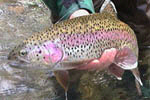Back
in the 70's, when I moved to Alaska from Virginia, I realized my fly
box selection would have to be revamped. I had read all I could
about fishing Alaska and knew the insect species were quite limited
as compared to the Virginia mountains. One thing I quickly learned
though: there were no shortages of mosquitoes.
I learned on my first remote
fishing trip why residents jokingly called mosquitoes the Alaskan
State bird. They were not only much more plentiful than I had ever
seen, they were hardier and extremely vicious. I've seen them crawl
out of deep snow on a nice spring day and fly directly at me with
one thing on its mind... my blood. Only the best of repellant
worked, and it became an important addition to my survival
kit.
Although I enjoyed salmon runs,
my main interest was fishing remote lakes and rivers for grayling
and rainbow. I was a pilot with my own airplane and so were several
of the guys I worked with. Most were fly anglers, and a few were fly
tiers, with the same interest I had. It didn't take long to learn
where, when, what, and how to fly fish remote Alaska.
As I said before, there were a
lot of mosquitoes, but there were also a lot of beetles. Beetles may
not have been popular in the lower 48 but they were one of our most
popular artificials for grayling in Alaska. They were especially
productive near overhanging vegetation near lakes and rivers on
gusty but fishable days in mid to late summer. I was never a Beatle
fan (John, Paul, George, and Ringo) but I was a beetle fan.
I would raft around the shoreline
of lake in the summer, sticking my arm in the water, looking for
warm pockets of water that were caused by thermal circulation and
nearby springs. I did this before plunging in when I needed a bath.
I also did it to locate the best areas to fish because rainbows and
grayling seemed to hang around and feed in the warmer pockets.
Stripping a beetle across the surface, a little slower than you
would imitate a caddis taking off, with frequent short pauses,
proved to be my most successful method.
After retirement, I moved back to
the Virginia mountains and found beetle patterns quite productive
there too. Many beetles mate and hatch in large numbers and
frequently fly or fall into the water. It would be beneficial for an
angler to have a few beetle imitations no matter where they fish.
Basic beetle shapes do not vary much so only a limited number of
patterns are needed. Even when fish are not keyed on specific prey
they may find a basic beetle pattern an offer they can not refuse.



